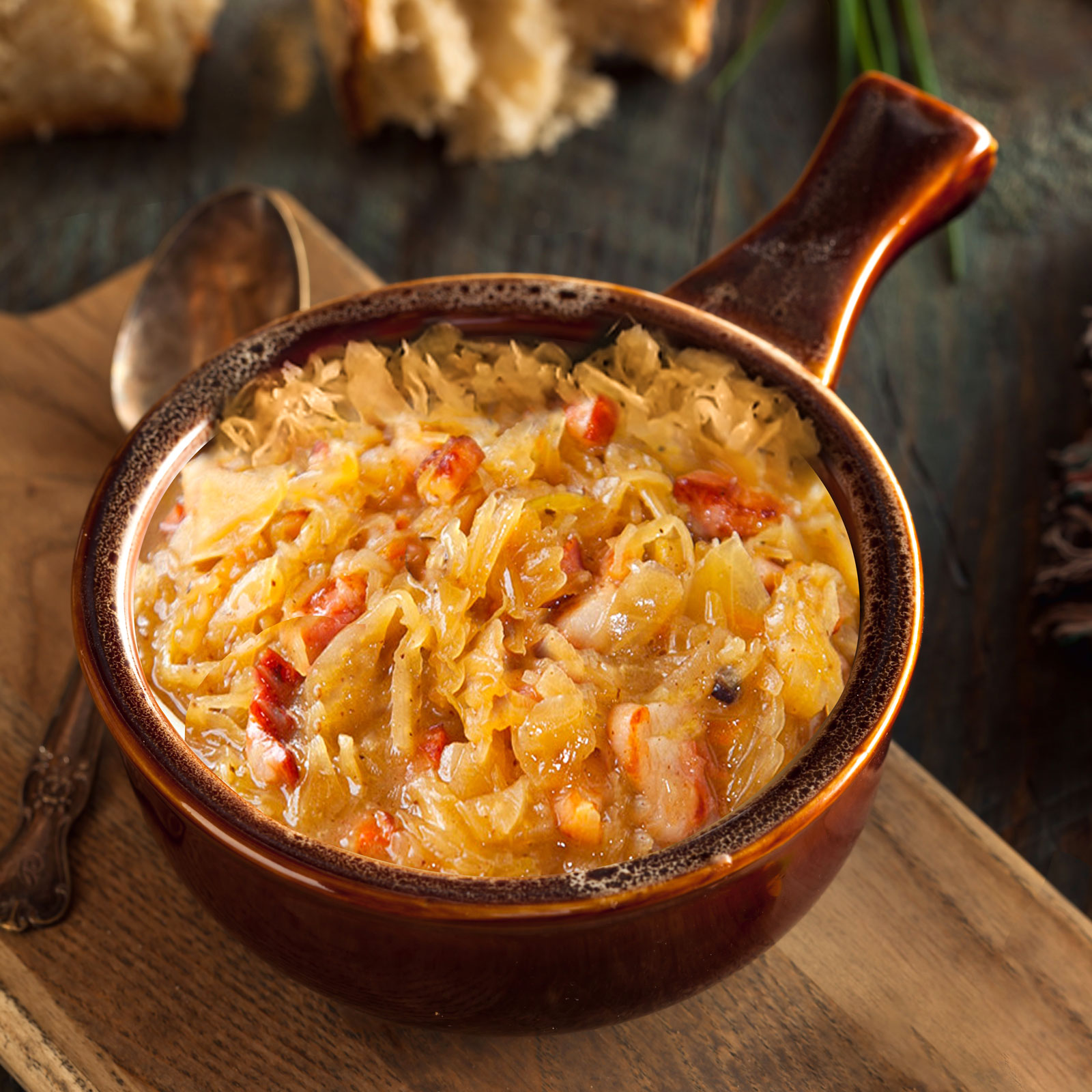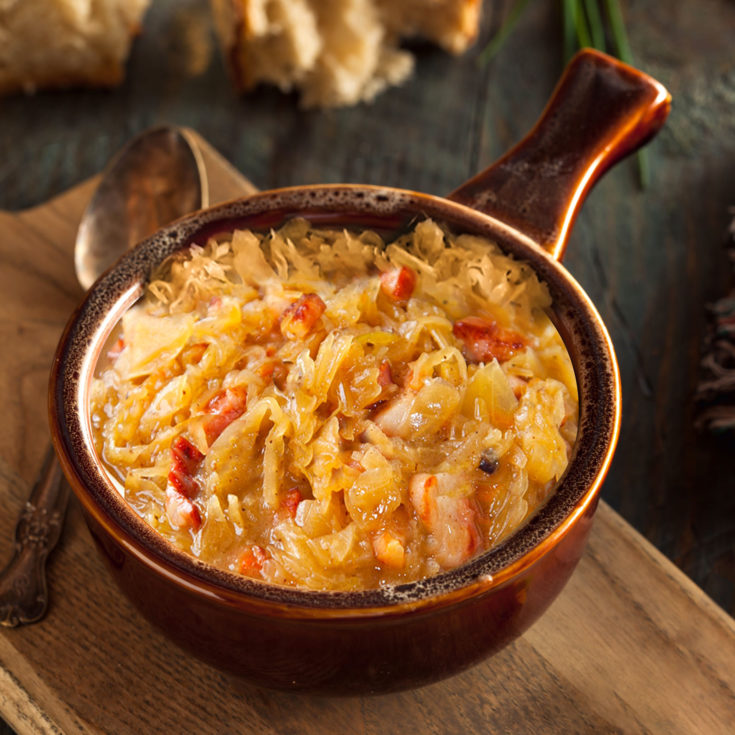Duszona Kapusta Kiszona
Polish Braised Sauerkraut
How to pronounce it?
dooshonah capoostah kishonah
‘Play’ to hear:

In this classic recipe, sauerkraut gets braised slowly, getting more tender by the minute. As it cooks, it’s partially submerged in the liquid, alongside an array of herbs and spices, such as cumin, bay leaves and allspice berries.
Braised sauerkraut has a very velvety texture, therefore it’s worth adding some crunch: fried onions and chopped bacon. To balance the acidity with sweetness, a small sweet apple gets added, making the flavours just right.
It’s worth noting, that some traditional recipes include fresh cabbage as an ingredient as well – so we’ll try it next time.
For the full list of ingredients & detailed instructions, please see the recipe card at the end of this post. But before you scroll, there’s important stuff to know below.
The consistency of Braised Sauerkraut is up to you: at some Polish homes, it’s served on a more runny side, almost soup-like.
Others prefer it thicker – and that’s where adding some roux (in Polish: zasmażka, pron. ‘za-smashkah’) comes in. It thickens the juices, making the texture more dense and creamy.
This sauerkraut side dish is easy, but it does take time. If you’re looking for a quicker solution, here’s a 5-minute Fried Sauerkraut recipe for you to try.
Do you need any special ingredients or equipment to make this Polish Braised Sauerkraut?
Most of the ingredients should be easy to find in any major supermarket.
When shopping for sauerkraut, it’s best to purchase it at a deli. Avoid canned products, most of them are unflavourful. Make sure that the sauerkraut was fermented naturally, without any vinegar or unnecessary additives.

Equipment-wise, you’ll need a deeper skillet/ frying pan, but a regular cooking pan with a thicker bottom will work just as well.
What could you serve with this Braised Sauerkraut?
This recipe makes an excellent side dish – it pairs beautifully with pork dishes, such as roasts, ham hocks and breaded cutlets. Serve it together with young potatoes (boiled or roasted).
Can you cook this Polish Braised Sauerkraut another way?
Yes, you can:
- Change the braising liquid: in this recipe, Sauerkraut is braised in water and its own juices – but feel free to swap the added water for (hard) cider, mild beer or dry white wine. This will make the Sauerkraut even more tender. Don’t worry about the alcohol content, it will all evaporate while braising.
- Change the cooking method: Instead of braising on the stove, braise it in the oven. 35-40 minutes in 360°F (180°C) is usually long enough. Start with a lid on, and then remove it after 30 minutes or so.
- Change ingredients: Swap soaked bacon for smoked kiełbasa sausage, chopped into small cubes.
What diets is this Braised Sauerkraut suitable for?
This recipe is gluten-free. It’s also low-carb / keto-friendly (just skip the apple and don’t season it with sugar). You can also skip the bacon and make this side dish suitable for vegetarians.
How long can you keep this Braised Sauerkraut in the fridge?
Once you’ve served it, ideally you should eat it within 3-4 hours.
To store any leftovers, let them cool completely and refrigerate in a container with a lid. You can keep leftovers of Braised Sauerkraut in the fridge for approximately 4 days.
If you plan to store this side dish for longer, it’s worth canning it in a jar. Alternatively, you can freeze it. More on that below.
Can I freeze this Braised Sauerkraut?
Yes, this recipe can be frozen, but please remember to freeze it as soon as it is cold enough to do so.
Use a container (or bag) that is suitable for freezing. Stick a label on with the description and the date. Aim to consume within 3 months.
How do I reheat this Braised Sauerkraut?
From chilled: Place in a microwave-friendly container covered with a loosely fitting lid. Heat for 4 to 6 minutes until hot throughout.
Alternatively, you can reheat it on the stove, stirring occasionally, to prevent the sauerkraut from sticking. If the dish becomes too dry, add some water. Cook on medium-low heat for 5-8 minutes, until hot throughout.
From frozen: Allow to thaw fully. Heat covered in the microwave for 3 to 5 minutes, then stir (carefully, it will get hot!). Continue reheating for a further 2-3 minutes, until hot throughout.

Polish Braised Sauerkraut

In this classic recipe, sauerkraut gets braised slowly, getting more tender by the minute. Goes brilliantly with pork dishes.
Ingredients
Braised Sauerkraut:
- 1 lb (450-500 g) sauerkraut
- Hot water, enough to cover and top up
- 2 tbsp butter
- 2 bay leaves, dried or fresh
- 1 tsp cumin
- 5 black peppercorns, whole
- 2-3 allspice berries
- 1 small (3.5 oz,100 g) sweet apple, optional
- 3.5 oz (100 g) smoked bacon, in bits/pieces, optional
- Pinch of salt, to season
- Pinch of ground black pepper, to season
- Pinch of sugar, to season
- ½ bunch fresh dill or parsley, optional
For the roux:
- 2 medium onions, finely chopped
- 1-2 tbsp flour
- ½ cup (100-120 ml) water or salt-free chicken stock
Instructions
- Drain the sauerkraut, keeping the juice (we won’t use it here, but feel free to drink it - it’s very healthy!). Have a taste - if the sauerkraut is extremely sour, it’s worth giving it a rinse under running water first, then squeeze it out.
- Roughly chop the sauerkraut, so that the strings of fermented cabbage aren't too long.
- Move the sauerkraut into a deep frying pan/skillet.
- Pour in enough hot water to nearly cover the sauerkraut.
- Add in 2 tablespoons of butter (don’t worry, it will melt on its own), 2 bay leaves, 1 tablespoon of cumin, 5 black peppercorns and 2-3 allspice berries.
- Cover with a lid and braise until soft. Sauerkraut will become soft after around 40 to 50 minutes of cooking. Monitor the process from time to time, making sure nothing boils over or sticks to the pan. Add more water if necessary.
- [optional step: apple] After 25 minutes of braising (somewhere around the half-way mark), add an apple. Peel one small sweet apple (weighing roughly 3.5 oz / 100 g before peeling) and chop it finely. You can also grate it instead (using the largest holes). Add the apple pieces into the sauerkraut and continue braising.
- [optional step: bacon] As the braising is nearing the end, let’s fry the bacon: Chop the smoked bacon into cubes (or small pieces) and fry them up on a separate frying pan until lightly golden. Usually bacon renders enough of its own fat, so no additional cooking fat is required - but if your bacon is very lean, feel free to grease the pan with some oil.
- Add fried bacon into the braised kraut, fold it in.
Sautéing the onions and preparing the roux:
- Add chopped onions into the same frying pan (same one we used for cooking bacon). Sauté them for a few minutes until they turn translucent.
- Add 1-2 tablespoons of flour into the onions, and stir them in (with a pan-friendly spoon or a spatula).
- Add in half a cup of water and stir continuously. Increase the heat and bring into a near-boil (keep on stirring!).
Finishing off:
- Move the contents of the frying pan (onions + roux) into the braising sauerkraut. Stir everything together.
- Have a little taste. Does it need some more salt and pepper? If so, season it a bit more, I usually do. If it tastes a bit too acidic for your liking, add a pinch of sugar. Stir everything together and switch off the heat.
- [optional step] Chop fresh dill finely and fold it into the sauerkraut. Serve hot.
Nutrition Information:
Yield:
4Serving Size:
1Amount Per Serving: Calories: 208Total Fat: 11gSaturated Fat: 5gTrans Fat: 0gUnsaturated Fat: 5gCholesterol: 27mgSodium: 414mgCarbohydrates: 23gFiber: 4gSugar: 10gProtein: 7g
Polonist is reader-supported. When you buy through links on our site, we may earn a small affiliate commission. Learn more
Recipe Information
Filed under:
Alternative traditional/regional names:
Also known / Misspelt internationally as:
Tested by:
First published on:
Recipe by / Adapted from:
Story by:
Bibliography / References: